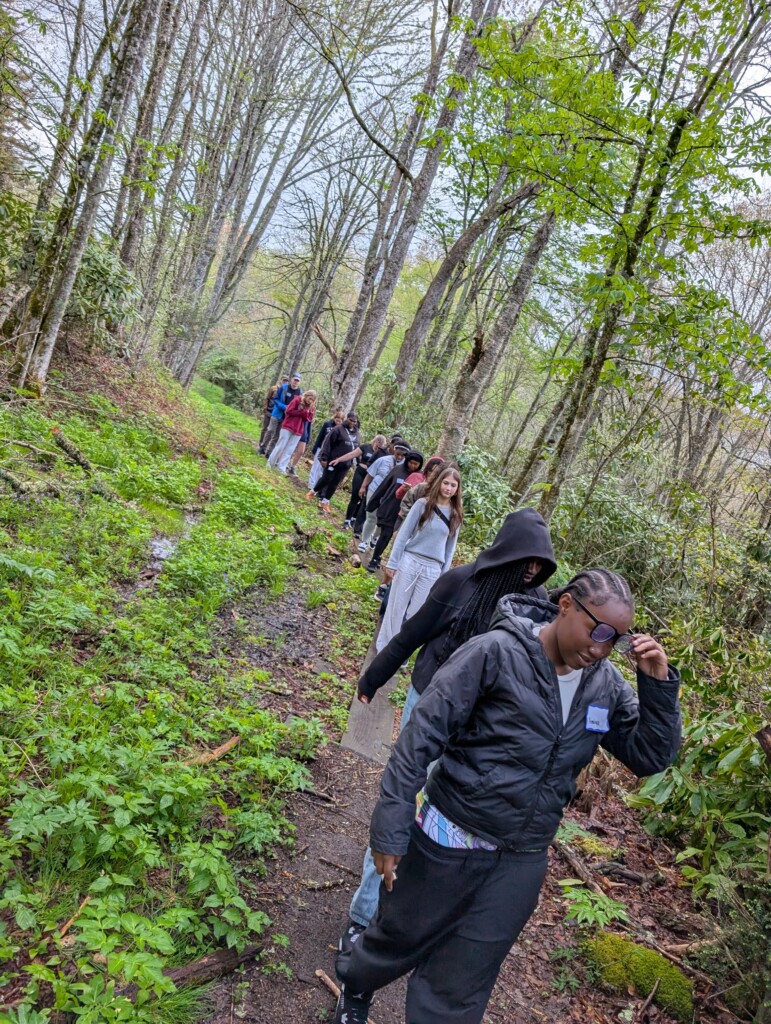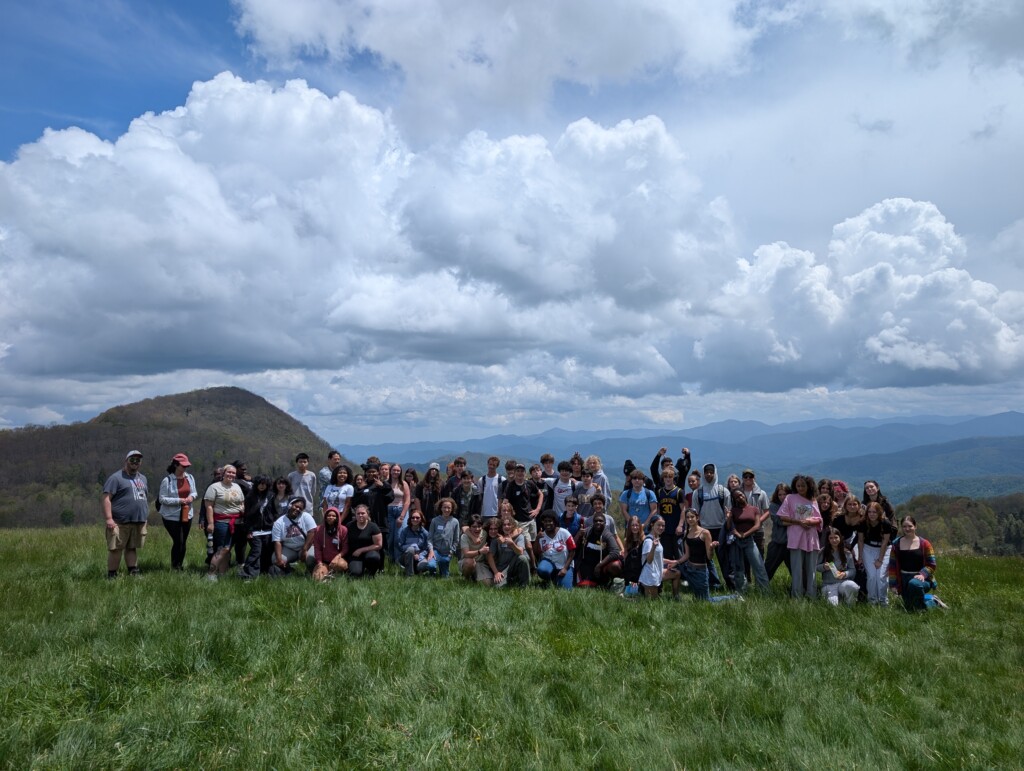By: Wesley Davis
Rising from the Storm: A Regional Call to Redesign
It’s a clear spring morning in 2025, and Tucker Waldron, science teacher, is watching a group of high schoolers from the School for Inquiry and Life Sciences Asheville scramble up a wooded hillside in the Great Smoky Mountains. There, students observe seasonal patterns and study indicator species to better understand the ecological complexity and distinct biodiversity of the Southern Appalachians. Just months earlier, many of these students had been navigating the lingering aftermath of Hurricane Helene, including school closures, weeks without clean drinking water, and a quiet undercurrent of loss. Now, out here in the woods, they’re reconnecting not just with nature, but with each other and themselves.
Western North Carolina is a place shaped by mountains, rivers, and deep-rooted communities. It’s also a region that has endured its share of hardship. Yet, in the wake of Hurricane Helene educators, students, and community members began asking two powerful questions: What if recovery could be more than rebuilding what we lost? What if it could be a chance to build something better?
The WNC Resilience Project emerged from those early conversations as a bold, collaborative effort to transform adversity into a catalyst for educational innovation and community healing. By early 2025, the effort had evolved into a region-wide, multi-year initiative. Supported by The Leon Levine Foundation and led by Open Way Learning, SparkNC, Education Reimagined, and the Public School Forum of North Carolina, the WNC Resilience Project positions school communities as co-creators of a future shaped by resilience, relevance, and learner-centered innovation.
I’ve had the privilege of co-designing with many Western North Carolina educators as they’ve prototyped new learning models, centered student voice, and sparked small changes with big impact. A clear truth emerged from these collaborations. This work is deeply personal, profoundly place-based, and bursting with potential.
As part of our early efforts to bring ideas to life, we offered a series of microgrants to support school- and community-led prototypes across the region. These were intentionally light-touch and flexible in order to catalyze action, not prescribe it. What followed was inspiring: students restoring riverbanks and planting native species, designing and testing 3D-printed wind turbines, launching trauma-informed SEL programs, and exploring new ways to credential real-world student work.
In the next three sections, you’ll meet three WNC educators, Tucker Waldron, Jasmine Bright, and Anna Rossino, who are turning microgrants into movements. Their projects reflect the diversity and depth of the region, and they offer a glimpse into what’s possible when we empower educators to lead from their context, with their students, and for their communities.

SILSA Outdoors: Learning in the Wild
For students at the School for Inquiry and Life Sciences Asheville (SILSA), outdoor learning has long been part of the school’s identity. But after Hurricane Helene disrupted daily life and left lasting physical and emotional impacts, the need to reconnect with the natural world and one another became even more urgent.
Led by educator Tucker Waldron, SILSA Outdoors treats field-based learning not as a one-time enrichment but as a central method for engaging students in academic content, building peer relationships, and fostering a strong sense of place. Each fall, new cohorts typically begin the year with a team-building trip to Blue Ridge Assembly, a historic YMCA retreat and leadership center nestled in the Blue Ridge Mountains. However, the storm forced the cancellation of that trip, and with no drinking water at school until February and some students and staff coping with personal loss, the opportunity to rebuild the community was more important than ever.
With support from a WNC Resilience Project microgrant, Tucker adapted by taking students to the Great Smoky Mountains National Park in the spring. There, they collected tardigrades and investigated the role of snails in ecological monitoring using place-based science to spark curiosity and reconnect with the world around them. That same funding is set to support next fall’s Blue Ridge Assembly trip, restoring the tradition for a new cohort.
To deepen the experience, Tucker is incorporating structured reflection, inviting students to document and share what they’ve learned through journals, photo essays, and presentations. The responses reveal a lasting impact:
“By being more aware of how important every little thing in nature is, I will be more careful about how I interact with nature.”
“Honestly, just enjoying and appreciating where I live more.”
“I’ve learned that I might want to work in national parks.”
SILSA Outdoors reminds us that resilience is not only built in classrooms. Sometimes it begins in the woods, where students rediscover themselves, each other, and their place in the world.
CWA What’s Next: Workforce Development and Real-World Readiness
For many teens in the Asheville area, traditional academic pathways don’t align with their lived experiences or professional goals. Jasmine Bright, Chief Impact Officer at the Christine Avery Learning Center’s What’s Next Workforce Development Program, saw this gap long before Hurricane Helene. But the storm’s aftermath brought the need for local investment into sharper focus. In past years, the program welcomed young adults from across the country. Today, its efforts are concentrated entirely on Western North Carolina youth.
The program provides paid, real-world experience in early childhood education, after-school programming, and nonprofit leadership. Participants aged 14–18 receive CPR and First Aid certification, earn credentials aligned with North Carolina’s Portrait of a Graduate, and engage in social-emotional development that supports both them and the children they serve. For many, it’s more than a job. “It’s a safe haven,” Jasmine said. “They feel supported. They feel seen. They’re not expected to carry the weight of the world on their shoulders here.”
That combination of support and structure is helping the region recover in more ways than one. In a place where affordable child care is scarce, the program fills critical workforce gaps by training young adults to become trusted educators and mentors in the communities they grew up in. As Jasmine explained, “They are becoming the caring adults their younger selves once needed.”
Few stories capture that arc more powerfully than Amber Redmon’s. She began as a camper in CWA’s after-school programs, became a counselor-in-training, and later earned her degree in social work. Today, she’s back in Asheville as a lead teacher in the two-year-old classroom. “CWA is the village every community needs,” Amber said. “Working here allows me to blend my personal child care experiences with my professional development as an educator.”
Looking ahead, the program is laying the groundwork to become a certified apprenticeship partner with AB Tech and Blue Ridge Community College, allowing interns to transition into higher education at low or no cost. While demand continues to grow, the team is focused on deepening impact, building lasting relationships, and preparing youth not just to work but to lead.
SEL Through Story: Building a Library of Resilience
At Ira B. Jones Elementary in Asheville, first-grade teacher Anna Rossino is helping students process a difficult year by centering stories and emotional connection. After Hurricane Helene, many students returned to school still dysregulated and unsure. “There was this lingering impact of kids not feeling safe or having questions or being able to regulate,” Anna explained. In response, she began to prioritize mental health and well-being alongside academic standards, creating a more stable and supportive environment for her students.
With support from the WNC Resilience Project, Anna has partnered with school counselor Courtney Booth to launch a schoolwide Social-Emotional Learning (SEL) library next fall. Each month, K–5 students will engage with an age-appropriate “Book of the Month” tied to a specific habit of character, such as perseverance or empathy. The goal is to build shared language and values across the entire school community. “I really want to create a sense of cohesion within our school,” she said. “If we’re cohesive as a school, it really helps inclusivity with all the adults… so that all of our kids can feel supported.”
The books will serve as both teaching tools and conversation starters, with activities tailored to each grade level. While the program officially starts next school year, Anna has already piloted similar lessons this year, including projects like self-talk flowers and bravery badges. “We’ve done different things that relate to skills we’ve learned about through read-alouds,” she said.
Looking ahead, Anna hopes this work can inspire district-wide alignment around student wellness. “SEL and well-being are so important,” she said. “If we could wrap ourselves around the importance of this learning and provide teachers with what they need so they’re not having to make the plans and buy the books themselves, that would be the ultimate goal.”
Connecting the Threads
While each of these projects looks different on the surface, they’re all rooted in the same essential idea: resilience is both personal and systemic. It’s built through relationships, relevance, and real-world learning that matters to students and their communities.
Tucker, Jasmine, and Anna show what’s possible when educators are trusted and supported. Their work embodies the mission of the WNC Resilience Project by blending experiential learning, mental health supports, and credentialing pathways with a shared belief that schools can be hubs of innovation and healing. And perhaps most importantly, they are doing this not in isolated classrooms, but in ways that ripple outward, connecting students to their place, their peers, and their purpose.
Across their stories, three patterns stand out:
- Agency: Students aren’t passive recipients of support; they are co-creators of change. Whether leading a nature hike, mentoring peers, or responding to literature through art, students are being positioned as leaders in their own learning and in their communities.
- Authenticity: Each project is deeply grounded in the real world. From career skills to emotional processing to environmental stewardship, learning is contextual, hands-on, and meaningful.
- Connection: Whether it’s to a natural landscape, a professional mentor, or a classroom community, these initiatives prioritize relationships as the foundation for growth—both academic and personal.
In a time when educational systems often default to “learning loss” narratives or top-down mandates, these stories offer something far more powerful: a glimpse into what happens when we lead with trust, empathy, and a shared vision for transformation.

Call to Action
The WNC Resilience Project aims to create a blueprint for how communities can reimagine education in the face of disruption. What began with a storm has grown into a movement powered by educators, grounded in place, and centered on the belief that healing and learning go hand in hand.
Over the next three years, the project will continue to grow across the region, supporting schools as they launch new prototypes, scale successful practices, and deepen their focus on student-centered, resilience-driven learning. From outdoor classrooms to micro-credentialing pathways to trauma-informed SEL ecosystems, these innovations are not only transforming classrooms, they’re influencing what’s possible for schools across North Carolina and beyond.
We know that lasting change requires both local leadership and widespread support. Stay informed about the WNC Resilience Project.
Wesley Davis is the Outreach and Program Director for Open Way Learning, a nonprofit committed to amplifying the joy and wonder of learning through co-design and learner-centered innovation. With a background in life science research and over twenty years in student-centered education, Wesley has helped students publish children’s books, conduct photo surveys to design zero-waste campuses, explore place through learner-designed field trips, and dream up woodworking projects that strengthen community connections. Wesley lives in Western North Carolina, where he partners with school communities to build cultures that support transformative change.
The post Resilience in Action: How Three Western NC Educators Are Reimagining Education After Disaster appeared first on Getting Smart.